Text



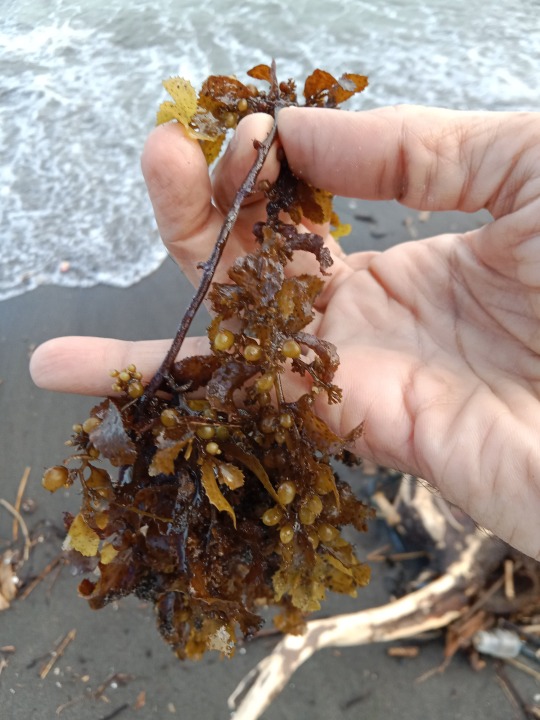


I will not even speculate as to the provenance of this brownish green seaweed that I picked up from the sands, that like the lone seashell I had picked up earlier existed in but a single copy. Certainly it couldn't have been any of the surrounding black rocks, none of which had even a single strand of seaweed, let alone being festooned by it as they are in India to the point where a rock can literally be cloaked in green.
It must have drifted from far off, the buoyancy conferring round spherical bladders to be seen like tiny grapes on this stem clearly pointing to this seaweed mass as being a reproductive structure capable of propagating this species across vast stretches of ocean. It could literally have come from anywhere, and need not have been of local provenance at all.
Dawis Beach, Digos City, Mindanao, The Philippines, January 26, 2024.
#seaweed#reproduction#air sacs#buoyancy#bladders#propagation#brown#green#seashore#beach#tropics#rock#fertility#sterility
6 notes
·
View notes
Text


The end of the concrete jetty jutting out into the sea. A massive encrustation of oysters were to be seen on one of the supporting concrete pillars, that were otherwise devoid of all life.
Dawis Beach, near Digos City, Mindanao, The Philippines. January 26, 2024.
#oyster#encrustation#sterility#jetty#concrete#pier#digos city#mindanao#philippines#marine biology#beach#seashore
5 notes
·
View notes
Text
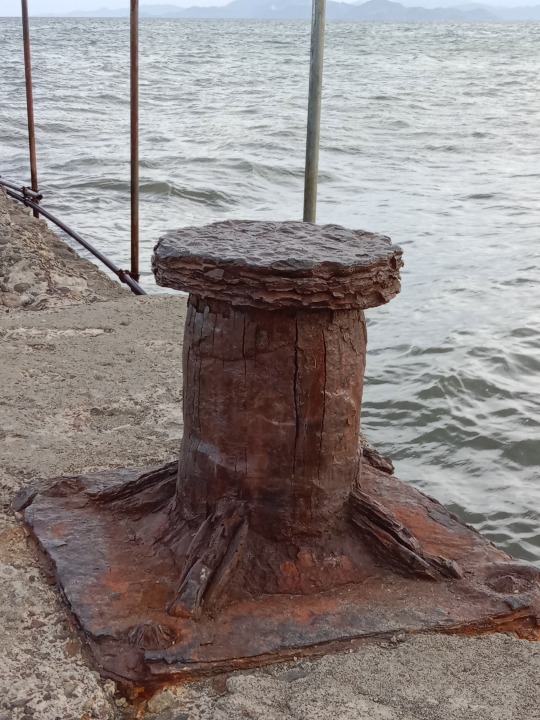
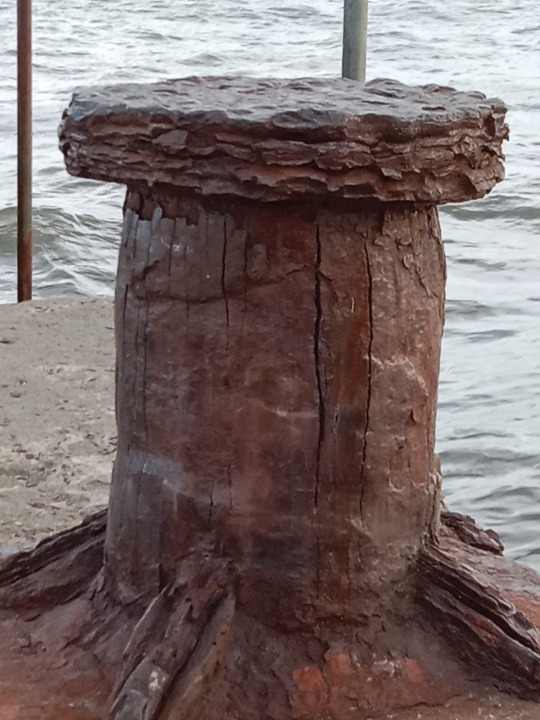
So heavily rusted was this metal bollard on a concrete jetty jutting out into the sea for about thirty feet that it almost resembled ancient teakwood!!! one had a hard time recognizing it for the metallic structure it in fact was..
The jetty was undergoing repair at the time I visited it, but one wonders at the faith of future boats who choose to use this rusted hulk as an anchoring point!!!.
Nothing brings out the crippling corrosive power of salt spray than do these stark images of corrosion gone absolutely amuck.
Dawis Beach, near Digos City, Mindanao, The Philippines, January 26, 2024.
#metal#corrosion#salt spray#teakwood#rust#bollard#jetty#anchorage#philippines#mindanao#electrochemical#seashore#beach#wharf#iron#steel
1 note
·
View note
Text

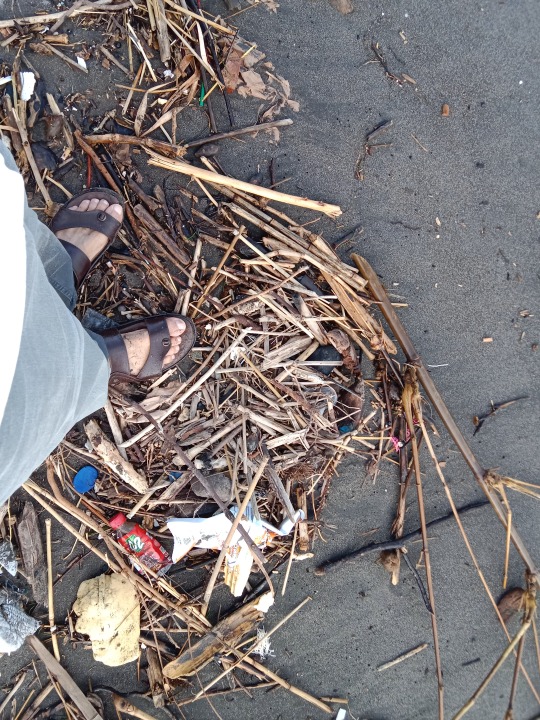
Plants are asocial, especially those that inhabit extreme environments as deserts, seashores and polar regions, and create space for themselves, and hoard scarce resources, by secreting toxic compounds called allelochemicals that essentially sterilize their vicinity of all life.
One such chemical is rotenone, a toxin so powerful it indiscriminately kills insects, plants, fish and mammals, it herbicide, pesticide and piscicide, by interfering with electron transport in their mitochondria.
Molluscan life on the seashore is thus most flourishing and abundant when botany is not allowed to get too close to it, and in nations like India beaten by the giant combers coming in from the open ocean, botany is indeed held at bay by their action, kept at a distance, its toxins not permitted to percolate and seep into the soil and kill off molluscan and other life in the vicinity.
In the enclosed waters that surround many of the islands in the Philippines waves do not have a chance to gain such momentum, and thus plant life approaches quite literally to the edge of the sea in many cases, as can be seen by the huge amount of driftwood piled up here on this shore, which close approach and unleashing of a flood of toxic chemicals would be expected to devastate molluscan communities, and might account for the stark sterility of the sea-sands witnessed here on Dawis Beach, literally no seashells, but for a single specimen - gastropods or bivalves - found here.
Dawis Beach, Near Digos City, January 26, 2024, Mindanao, The Philippines.
#seashore#beach#tropics#sterility#allelochemicals#rotenone#mitochondrial electron transport#toxicity#plant ecology#molluscs#bivalves#gastropods
1 note
·
View note
Text
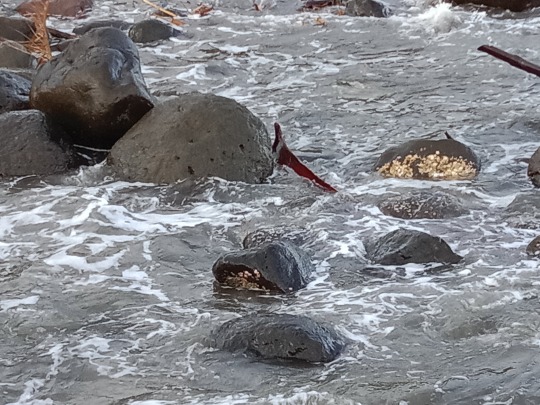
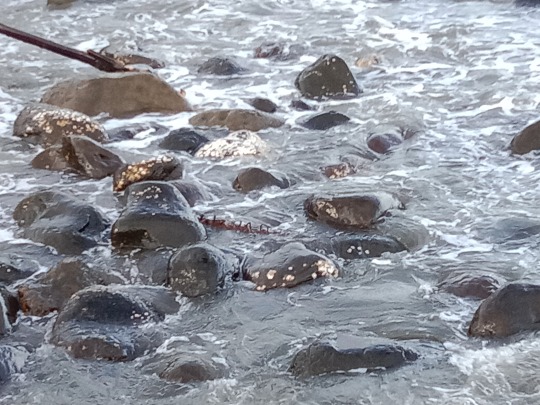
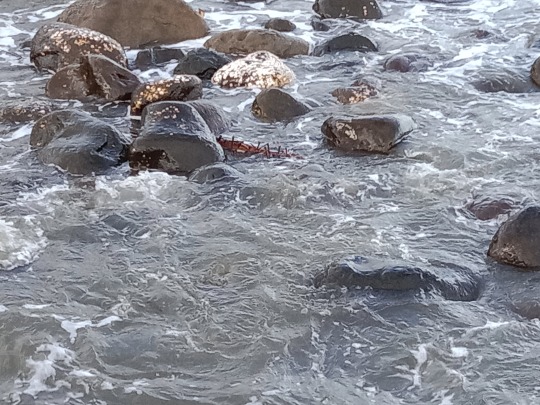
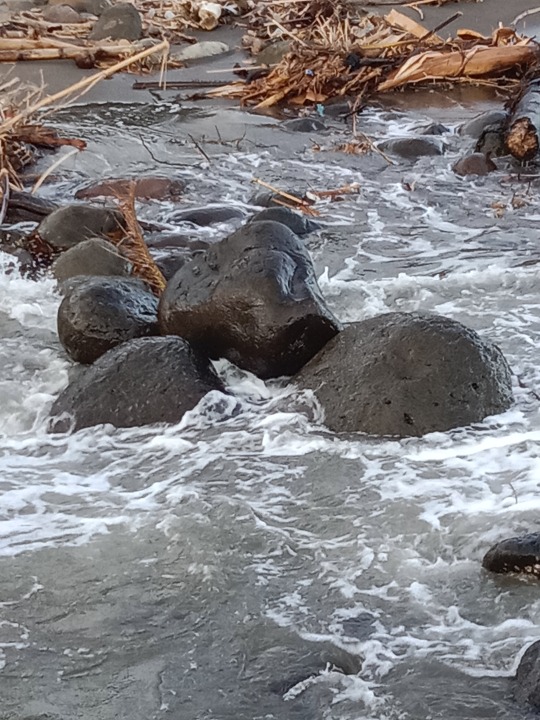
The molluscan sterility that marked the seashore, marked the inshore rocks as well. Expect for a few rocks that bore white blotches of Oyster encrustations, these black boulders were almost lunar of aspect, their black surface devoid of seaweed, periwinkles, barnacles, and even for that matter skittering crabs, they wont to scamper back on the seashore rocks of Andhra Pradesh, India, in literal swarms.
The rocks themselves though were interesting in their physical geology characteristics - nice rounded humps that looked almost man-made, a shoal of rounded rocks as it were.
Dawis Beach, January 26, 2024, Digos City, Mindanao, The Philippines.
#physical geology#beach#rock#boulders#crabs#seashore#sterility#tropics#lunar#india#seaweed#periwinkles#oyster#molusc#mindanao#rounded rocks
3 notes
·
View notes
Text


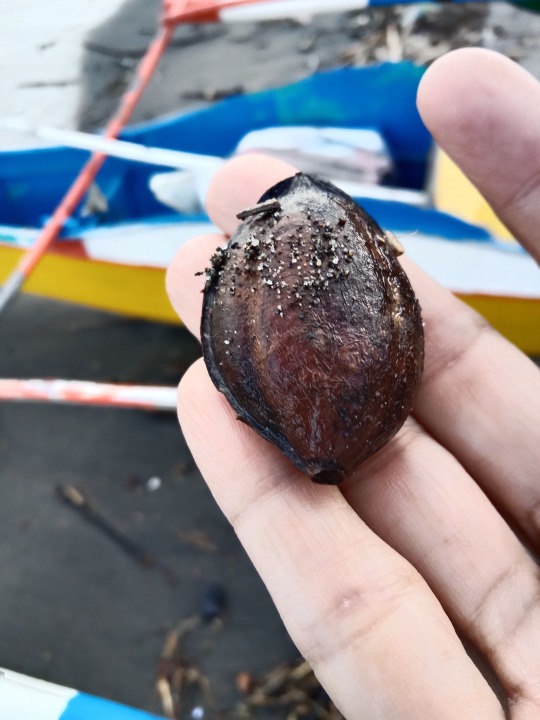

What were abundant on this shoreline, devoid of all molluscan shell debris, let alone of intact seashells, were these elliptical seed pods, presumably buoyant, that help spread the species along the coastline. Huge numbers of them were present here, they ubiquitous on this shore, to the point of being overkill.
A strange seashore indeed, marked by molluscan infertility and botanic fertility!!!!, a similar situation witnessed on a certain sector of the Andhra coastline in India by me, although the norm is that molluscan fertility far exceeds that of any shoreline plant species, seashells everywhere, plant propagative structures few and far between.
Davis Beach, near Digos City, Mindanao, The Philippines. January, 2024.
#digos city#mindanao#plant ecology#seashore#seed pod#beach#seed dispersal#buoyancy#dawis beach#philippines#sterility#fertility
1 note
·
View note
Text

The Science Research Notebooks of Satyendra Sunkavally. Page.1.
#origin of life#clay#deoxygenation#glauconite#potassium#biogenesis#sodium#mica#abiogenesis#transmembrane potential#marine life
5 notes
·
View notes
Text





This single, sad seashell was the only seashell I was able to find on this beach of fine sand that was as dark of hue as it was utterly devoid of all life. It is true that I only walked about thirty feet on this very long beach, whose beached boats prevented the easy moving around, yet it is an assessment of sterility I was able to make with confidence for it was utterly devoid of all fragments of seashell too, not the tiniest piece of glistening calcium carbonate presence betraying the existence of ANY molluscan life here, the black sands bleak and brooding.
it should not to be thoughts that the offshore waters are devoid of life given the abundance of fishing boats; while the waters were molluscan-poor, they certainly were not piscine-poor!!!
Never in India had I struck a coastline of such stark sterility, even the black boulders on the other side of the concrete jetty twenty feet away devoid of all limpets and barnacle encrustations except for a single solitary boulder that bore a bunch of splotches of white, as will be seen in subsequent photos.
In what startling contrast to the shore of Mactan Beach, Cebu that was literally a riot of seashells!!!
Even this one seashell looked out of place, its color and morphology resembling more those of the shells found in riverine and freshwater environments than are found in the sea.
Dawis Beach, near Digos City, Mindanao, The Philippines. January 26, 2024.
0 notes
Photo
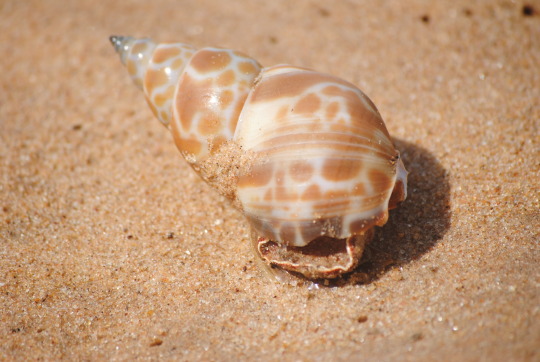
The whelk Babylonia zeylanica. This marine gastropod has been reported from Taipei, to as far afield as Mauritius. But its most heavily reported presence is on the southern and southeastern coasts of India - primarily Tamil Nadu and Kerala - and I think this article is the first reportage of it being found this far up north on the eastern coastline of India, in Andhra Pradesh itself.
This sea snail inhabits the deeper benthos - which is why the intact seashell is but rarely - if ever - washed up onto the seashore, at least here in Andhra Pradesh, and never in this pristine a condition; clearly it represents a discarded by-catch of the fishing boats here.
In Kerala however its population can reach such densities that “fishing” for this gastropod - by boats equipped with nets specifically modified to catch this beautiful benthic beast - is a profitable proposition, with the whelk meat being actually exported.
With its beautifully reticulated brownish-orange spots on a white background and super smooth shell - notice the line of shiny gleaming spots - one feels that this wonderful whelk is far too beautiful to ever have to die, let alone in such prodigious numbers. But then such is Reality; everything and everyone needs to live including the fishermen and their families.
The blotched beast reproduces sexually accounting for its beautiful hues and patterns which serve to attract a mate which presumably possesses a form of coloured vision. I searched the Internet for specific information on the presence of a lensed eye in this gastropod, and surprisingly there was none!!!!, a virgin field ripe for study by a marine biologist.
Predators - be they tigers, or cheetahs, or sharks or cones - are beautiful, and the fact that this beautiful beast is a carnivore comes as no surprise to us. And a rather successful one apparently for this marvelously mottled mollusc is reported to have arisen 23.03 million years ago, its pedigree as a species far longer than ours with our paltry 5 million years!!!
Some other pertinent precision facts - about 53 mm long; dark tip of the spire; wet weight about 19.7grams; shell coils dextrally; movement: mucus mediated gliding; body volume: 11.3 cubic centimeters.
Gosthani confluence, Bheemili, Andhra Pradesh. This seashell location approximately 17N latitude. May 10, 2010.
#babylonia zeylanica#whelk#mottled#andhra pradesh#location#latitude#evolution#geographic location#carnivore#babyloniidae#sexual reproduction#mate selection#mucus#gliding#locomotion#vision#weight#volume#length#commercial#fishing
6 notes
·
View notes
Photo

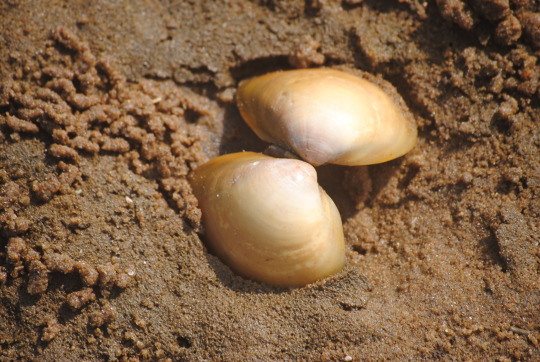
Once again we witness the repetitive leitmotif, albeit a puzzling one, that molluscan species that inhabit estuarine environments display the most drab and dismal and dilute of colours, the coloured concinnous patterns that routinely mark the seashells just a short distance away in yonder surf, a riot of pattern and colour as it were, utterly absent here. It is a peculiar fact that freshwater bivalves and gastropods right up to the debouching estuaries are devoid of decoration, presumably because in that murky turbid water it is difficult for a prospective mate to see colour and coloured patterns.
The fact that these bivalves bury themselves most of the time and thus are not visible is no explanation, for the bivalves out in saltwater do too, yet bear a ravishing riot of colour and pattern of breathtaking beauty.
In fact even to an avid, ardent avowed seashell collector these shells look not just plain but awful, and it is only academic interest that makes one bend and pick them up..
Gosthani River Confluence, May 10, 2010, Bheemili, Visakhapatnam, Andhra Pradesh.
#bivalve#estuary#riverine#colour#pattern#andhra#gosthani#mate selection#drab#gastropods#turbidity#visibility#mollusca#concinnous#murkiness
1 note
·
View note
Photo

Aphorism 180. The Philosophy of Tropical Littorals and Seashores.
Satyendra Sunkavally.
#aphorism#pollution#planetary destruction#global warming#ozone layer#despoliation#smog#existential threat#extinction#planet earth#purity#pulchritude#satyendra sunkavally#philosopher#philosophy#seashores#plastic pollution#oil spill#pillaging#misnomer#homo sapiens#evolution#human behaviour#warning#garbage#dumpster
10 notes
·
View notes
Photo


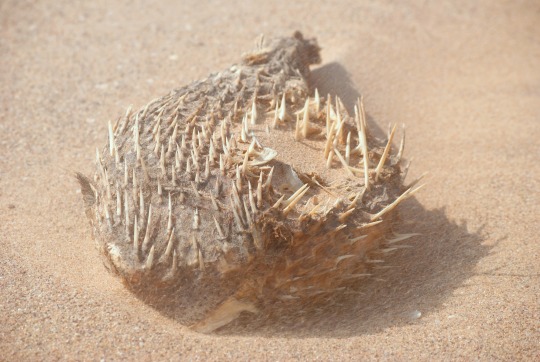
Diodon holocanthus. This specimen, a good two feet long, was so far up on the sands, beyond the wetting surf-line, even at high tide, that in the intense drying heat and the dry desiccating sands it was well on its way to mummification!!!
The pale sandy colour of this beast is a lovely match to the equally pale colour of the surrounding sands, and thus was by no means easy to spot despite its large size.
Those wicked-looking spines erected in its death throes - their purpose being, along with the bloated configuration, to make the beast both difficult and painful to ingest by would-be predators - are not normally perpendicular to the body, as seen so dramatically in these photos, but lie depressed longitudinally onto the body to facilitate streamlining during swimming.’It is only when the beast is threatened that the two-rooted spine is deliberately erected.
How it got this high up the shoreline is a mystery to me. It couldn’t have been a wash-up for then it would still be lapped by the surf. Apparently it must have been caught in a fisherman’s net and constitutes a discard, its flesh evidently inedible.
For obvious reasons, the big, bristling beast is also called the long-spined porcupine fish.It inhabits the muddy bottoms of lagoons and estuaries and has fused teeth in both its upper and lower jaws that constitute continuous sharp edged plates that it uses to literally crush the shells of mollusks and consume their otherwise inaccessible flesh. Crabs too are its victims.
One understands now why Telescopium telescopium, a gastropod that inhabits in large numbers the muddy bottoms of the Gosthani estuary, has such a disproportionately thick shell - giving it an impressive heft and heaviness despite its compact size - apparently to withstand these massive crush pressures!!! that if encountering the finger of a hapless human swimmer would have little trouble truncating them in two!!
The fact that these beasts actually swim around in SHOALS in the open ocean would give one the heebie-jeebies if swimming in the sea!! one could well emerge out sans fingers and toes!!!
The porcupine fish isn’t exactly a piranha, but one is in no hurry to determine if it can act as one if in a bad mood!!!
May 10, 2010, Gosthani River confluence. Bheemili, Andhra Pradesh.
#diodontidae#diodon#holocanthus#porcupine fish#telescopium#gastropod#spine#bloated#defence#depressible#gosthani#river#confluence#andhra pradesh#muddy#bottoms#predation#seashore#visakhapatnam#robust#calciumcarbonate#feeding#food#heft
3 notes
·
View notes
Photo

The philosophy of tropical littorals and seashores.
Parapet of the promontory overlooking the inlet waterway to Visakhapatnam Port. June 15, 2022.
#constable painting#painting#constable#seashore#philosophy#philosopher#satyendra sunkavally#littoral#details#tropics#seventeen degrees latitude#beaches#visakhapatnam#andhra pradesh#richness of detail#rumination#reflections#philosophical#latitude
2 notes
·
View notes
Photo

Beach birds winging their way over the lustrous liquid silver of the Gosthani River.
The glare here is so intense and must be borne by these birds for such sustained stretches, essentially the entire day, that one marvels these birds do not develop an avian version of snow blindness!!.
We need sunlight to see but sunlight is also detrimental to sight!!!. The ultraviolet rays present in it can cause an opacity of the eye lens - cataract - a serious matter considering that this causes blindness in about 25 million people worldwide. And if there is one species that truly needs ultra-sharp vision for its livelihood it is the high-flying bird!!! Birds don’t peer!!!.
The UV glare from the mobile mirror-like surface of these water apparently cause photo-oxidation of the crystalline proteins in the eye lens, not to mention the generation of superoxide and other reactive oxygen species that do further damage.That the eye lens contains one of the highest concentrations of the antioxidant Ascorbic Acid does not now surprise us!!!
The eye lens is especially vulnerable not only because its proteins are held at super-saturation, making them very vulnerable to precipitation by any chemical or mechanical injury, but in addition do not undergo any molecular or cellular turnover. The lens proteins you are born with are all that you will have for life, and upon reflection it is little short of a molecular miracle that they stay clear and crystalline as long as they do - seven decades.
Cataracts due to relentless sun exposure and glare while out at sea in low-lying boats - that shortens the distance between the shiny surface and the eye - beset the 50,000 fisherman of Srikakulam district - about 130 kilometers from here - many of whom develop lens opacities in their forties precluding many of them then from making a living, a serious matter in a people who essentially live from hand-to-mouth..
How these birds - doubtless long-lived, and fishermen in their own right!! - manage to keep their eyes and vision intact over a lifetime - assuming they do, they well might not - is a puzzle that needs explication.
The puzzle is further accentuated by the fact that reflected light is mostly polarized light, and as the pharmaceutical industry has known for a long time, polarized light is far more potent in producing molecular damage than un-polarized light.
May 10, 2010, Gosthani River confluence, Bheemili, Visakhapatnam, Andhra Pradesh.
#cataract#fishermen#opacity#eye lens#srikakulam#tryptophan#photooxidation#supersaturation#crystalline proteins#ultraviolet#glare#snow blindness#beach birds#avian#vision#reflection#catoptric#polarized light#superoxide#reactive oxygen species#antioxidant#ascorbic acid#reflectivity#andhra pradesh
3 notes
·
View notes
Photo

The Philosophy of Tropical Littorals and Seashores.
Parking space of the promontory overlooking the inlet waterway of Visakhapatnam Port, June 15, 2022, Visakhapatnam, Andhra Pradesh.
#sunlight#clarity#bliss#beauty#sublime#warmth#supernal#suffusing#quotidian#daily#visakhapatnam#andhra pradesh#promontory#parking space#port#calm#lolling#languorous#relaxing#delightful day#peaceful#balm#satyendra sunkavally#philosopher
0 notes
Photo

The Philosophy of Tropical Littorals and Seashores.
Parapet of the promontory overlooking the inlet waterway of Visakhapatnam Port. June 15, 2022. Visakhapatnam, Andhra Pradesh.
#deforestation#tropics#harbour#umbelliferous#undergrowth#mountain slope#copse#untrammeled#clichê#forest#nest#philosophy#littoral#port#satyendra sunkavally#philosopher#seashores#wilderness#luxuriant#serene#slopes#shrub
0 notes
Photo
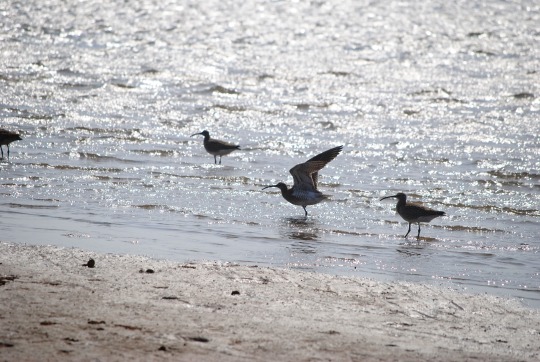

Such is the astonishing reflectivity of water, a parameter that increases exponentially once the angle of incidence of light exceeds the Brewster’s Angle of 53 degrees, that it has no trouble literally converting itself into a silver mirror that provides now such a bright, brilliant and burnished background as to guarantee the supernal, superlative silhouette, as witness these beautifully silhouetted beach birds standing stock-still on the riverbank of the Gosthani. The effect is enhanced by the fact that the electric vector of any electromagnetic wave - light being one - can be resolved into both a horizontal component and a vertical component, and that for substantial stretches of degrees both above and below the Brewster’s Angle the horizontal component is fully absorbed by the water; which means that predominantly pure polarized light, now exclusively polarized in the vertical direction, enters the camera. As any professional photographer knows the astonishing glare and catoptric reflectivity of polarized light can vastly increase the sharpness and darkness of a silhouette, water itself performing the function of a polarizer here. We find that the lustrous, light-lit littoral is a magisterial metaphysical mirror that outlines both forms and philosophies.
May 10, 2010, Gosthani River confluence, Bheemili, Andhra Pradesh.
#brewster#angle#catoptric#reflectivity#shine#silhouette#polarization#sunlight#water#river#riverbank#seashore#gosthani#brilliant#silver#liquid#polarized light#burnished#andhra pradesh#horizontal component#vertical component#glare#contrast#saturation#darkness#metaphysics#philosophy#littoral
0 notes